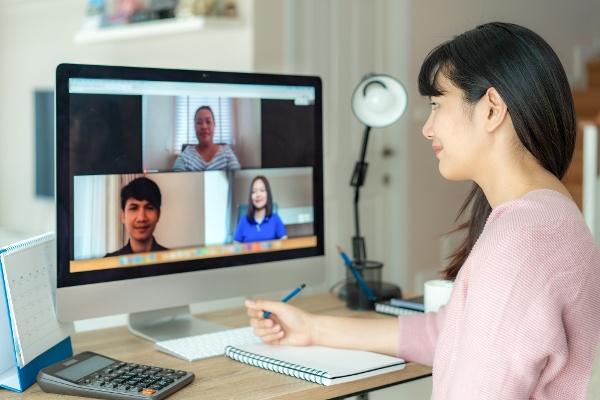COVID-19 changed the way all Americans go to work. Almost overnight, workers either had to wear PPE to protect themselves onsite or quickly set up a home office to keep their companies running. While working from home definitely has its perks, like a super casual dress code, it also can have a few hiccups mainly when it comes to company meetings. How many times have you said, “Can you hear me?” or, “I think we lost Sharon or Bob or [Insert Name Here]?” For some, virtual meetings might be a totally brand new experience, for others (like your remote workers), they might simply need to work out some bugs to make their video conferencing game solid. Even as offices reopen, now that U.S. workers have shown they can be productive anywhere, it’s unlikely virtual meetings will go away anytime soon. So, for Sharon’s sake, Bob’s sake and everyone else’s sake, follow our advice on running a great virtual meeting.
Your Working Environment
When prepping for a virtual meeting, especially from home, try to mimic the environment in your office. Just as you wouldn’t hold a meeting in the middle of a loud breakroom, don’t hold one virtually in similar circumstances.
- Choose a private, quiet space. Whether it is a conference room, bedroom or basement, find a spot where you can shut out the outside world. One of the biggest detriments to productivity is distractions. Quiet spaces reduce workplace distractions by 38%. The weather may be nice outside but if attending a virtual meeting from your deck means your co-workers have to hear lawnmowers and garbage trucks, it will be less distracting to hold it inside instead.
- Turn the lights on. It is important to be able to both audibly and visually engage with your coworkers while video conferencing. If your coworkers can’t see your facial expressions, it’s hard to tell how you’re receiving the information being given. Turn on an overhead light or lamp to help illuminate your face.
- Tidy up. Not only does a messy desk distract you from your work but it can distract your coworkers as well. Keep the space clean and reduce clutter. Also, while your artistic style in your home is up to you, when you’re on a work call, the décor should be work appropriate.
- Reduce any other distractions. It can be difficult to work from home when you’re sharing spaces with other family members. Remind spouses and kids that when you’re in a meeting you shouldn’t be disturbed. Keep the volume of devices, TVs and speakers low or enforce a headphone rule.
{{cta(‘a906da99-d18b-4a6a-831a-9ed4b6d354d8’)}}
Your Technology
Your home may not offer the same level of tech support that your office does, but there are things your remote team can do to make a virtual meeting go smoothly.
- Test your connection. According to Udemy’s 2018 Workplace Distraction Report, 33% of meetings get disrupted due to technology and connectivity problems. Many video conferencing tools, like Zoom and Microsoft Teams, allow you to check your audio and visual settings prior to meeting. Once everyone gets on the call, do a quick check to make sure everyone can see and hear the speaker.
- Blur your background. No matter how clean your area is, it can still be distracting. If you can’t make your at-home work environment ideal, blur your background. Both Zoom and Teams offers features that allow only you to be clear on camera.
- Turn your mic off when you’re not speaking. Your microphone can pick up all sorts of ambient noises like sips of coffee, fidgets, coughs and outside sounds. Eliminate distracting sounds and potential feedback by muting your microphone whenever you’re not speaking.
- Use the Chat function. If you do need to ask a question, use the chat function, especially if there are several participants on the conference call. Typing a question or response, instead of asking it aloud, will eliminate distracting sounds.
Your Etiquette
Video conferencing etiquette is just as important as the environment and technology. You can put a lot of work into setting up a good meeting but if the participants aren’t taking it seriously, everyone’s time is wasted. A virtual meeting should be just as important as one in-person.
- Choose a moderator. When figuring out how to run a virtual meeting, designate one person to lead the meeting. A moderator will not only control the agenda but the pace of the meeting, keeping everyone on track. The moderator should also have the administrative ability to mute participants and control other technical aspects of the software.
- Wait your turn to speak. Without physical cues, and delays in connection speed, figuring out when to speak can be a challenge. Waiting a couple of extra seconds before speaking can help eliminate talking over each other. Let the moderator call on people to talk, even virtually going around the table or raising a virtual hand to ensure introverts get their chance to speak.
- Be present with your co-workers. Refrain from reading or writing emails and other work during your virtual meeting. Look your co-workers in the eye and give them your full attention. Also, when speaking, look into your camera instead of looking at yourself on camera to help others on the call feel engaged.
- Dress for your audience. Even though a meeting is being held from your home, you shouldn’t dress like you just rolled out of bed. Wear professional clothing, adhering to your office’s dress code, at least from the waist up.
Making the transition to an in-person staff to an all-remote team and then back again can be a struggle. But if you already have IT infrastructure in-place for remote work, seamless communication tools and mobile-friendly HR software, your employees will be better equipped to go with the flow. BirdDogHR’s modular, HR Management Software is completely mobile-compatible, allowing employees to easily and safely access information anywhere, anytime. Contact us or schedule a demo today for more information.




